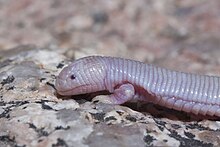Bipedidae: Difference between revisions
Content deleted Content added
No edit summary |
Adding information about Bipedidae |
||
| Line 12: | Line 12: | ||
}} |
}} |
||
'''Bipedidae''' is a [[Family (biology)|family]] of [[Amphisbaenia|amphisbaenians]] that includes the extant [[genus]] ''[[Bipes (lizard)|Bipes]]'' represented by three [[species]] from [[Mexico]] and the extinct genus ''[[Anniealexandria]]'' represented by one species that lived in what is now [[Wyoming]] during the earliest Eocene around 55 million years ago. [[Phylogenetic analysis]] indicates that Bipedidae is most closely related to the family [[Blanidae]], which includes the living genus ''[[Blanus]]''<ref>{{cite book |last1=Pough |first1=F. Harvey |title=Herpetology |date=2016 |publisher=Sinauer Associates Inc. |location=Sunderland, MA |pages=134-135 |edition=Fourth}}</ref>.<ref name=LVPPG15>{{cite journal|doi=10.1098/rspb.2014.3034|title=Biogeography of worm lizards (Amphisbaenia) driven by end-Cretaceous mass extinction |journal=Proceedings of the Royal Society B: Biological Sciences |volume=282 |issue=1806 |pages=20143034 |year=2015 |last1=Longrich |first1=N. R. |last2=Vinther |first2=J. |last3=Pyron |first3=R. A. |last4=Pisani |first4=D. |last5=Gauthier |first5=J. A.|pmid=25833855|pmc=4426617}}</ref> |
'''Bipedidae''' is a [[Family (biology)|family]] of [[Amphisbaenia|amphisbaenians]] that includes the extant [[genus]] ''[[Bipes (lizard)|Bipes]]'' represented by three [[species]] from [[Mexico]] and the extinct genus ''[[Anniealexandria]]'' represented by one species that lived in what is now [[Wyoming]] during the earliest Eocene around 55 million years ago. [[Phylogenetic analysis]] indicates that Bipedidae is most closely related to the family [[Blanidae]], which includes the living genus ''[[Blanus]]''<ref>{{cite book |last1=Pough |first1=F. Harvey |title=Herpetology |date=2016 |publisher=Sinauer Associates Inc. |location=Sunderland, MA |pages=134-135 |edition=Fourth}}</ref>.<ref name=LVPPG15>{{cite journal|doi=10.1098/rspb.2014.3034|title=Biogeography of worm lizards (Amphisbaenia) driven by end-Cretaceous mass extinction |journal=Proceedings of the Royal Society B: Biological Sciences |volume=282 |issue=1806 |pages=20143034 |year=2015 |last1=Longrich |first1=N. R. |last2=Vinther |first2=J. |last3=Pyron |first3=R. A. |last4=Pisani |first4=D. |last5=Gauthier |first5=J. A.|pmid=25833855|pmc=4426617}}</ref> |
||
'''Bipedidae''' are worm lizards that have large mole-like limbs that each include five claws. They have a short tail that does not regenerate if lost. Bepididae are very small usually ranging from 120-240 mm. They use their blunt head for burrowing by ramming it into the soil. Bipedidae usually prey on arthropods, and they can be found in Baja, California and the southern coast of Mexico<ref>{{Cite book |last=Vitt |first=Laurie J. |url=https://www.worldcat.org/oclc/839312807 |title=Herpetology : an introductory biology of amphibians and reptiles |date=2014 |others=Janalee P. Caldwell |isbn=978-0-12-386919-7 |edition=4th edition |location=Amsterdam |oclc=839312807}}</ref>. |
|||
== References == |
== References == |
||
Revision as of 23:33, 22 April 2022
| Bipedidae | |
|---|---|

| |
| Mexican mole lizard (Bipes biporus) | |
| Scientific classification | |
| Domain: | Eukaryota |
| Kingdom: | Animalia |
| Phylum: | Chordata |
| Class: | Reptilia |
| Order: | Squamata |
| Clade: | Amphisbaenia |
| Family: | Bipedidae Taylor, 1951 |
Genera
| |
Bipedidae is a
Bipedidae are worm lizards that have large mole-like limbs that each include five claws. They have a short tail that does not regenerate if lost. Bepididae are very small usually ranging from 120-240 mm. They use their blunt head for burrowing by ramming it into the soil. Bipedidae usually prey on arthropods, and they can be found in Baja, California and the southern coast of Mexico[3].
References
